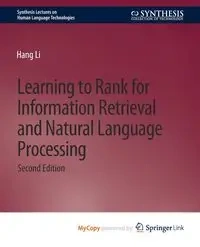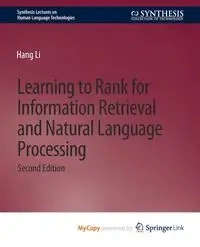Learning to Rank for Information Retrieval and Natural Language Processing, Second Edition - Li Hang
Learning to Rank for Information Retrieval and Natural Language Processing, Second Edition - Li Hang
AutorzyLi Hang
EAN: 9783031032837
Symbol
371HKH03527KS
Rok wydania
2014
Strony
124
Format
19.1x23.5cm
Język
angielski

Bez ryzyka
14 dni na łatwy zwrot

Szeroki asortyment
ponad milion pozycji

Niskie ceny i rabaty
nawet do 50% każdego dnia
Niepotwierdzona zakupem
Ocena: /5
Symbol
371HKH03527KS
Kod producenta
9783031032837
Rok wydania
2014
Strony
124
Format
19.1x23.5cm
Język
angielski
Autorzy
Li Hang

Learning to rank refers to machine learning techniques for training a model in a ranking task. Learning to rank is useful for many applications in information retrieval, natural language processing, and data mining. Intensive studies have been conducted on its problems recently, and significant progress has been made. This lecture gives an introduction to the area including the fundamental problems, major approaches, theories, applications, and future work. The author begins by showing that various ranking problems in information retrieval and natural language processing can be formalized as two basic ranking tasks, namely ranking creation (or simply ranking) and ranking aggregation. In ranking creation, given a request, one wants to generate a ranking list of offerings based on the features derived from the request and the offerings. In ranking aggregation, given a request, as well as a number of ranking lists of offerings, one wants to generate a new ranking list of the offerings. Ranking creation (or ranking) is the major problem in learning to rank. It is usually formalized as a supervised learning task. The author gives detailed explanations on learning for ranking creation and ranking aggregation, including training and testing, evaluation, feature creation, and major approaches. Many methods have been proposed for ranking creation. The methods can be categorized as the pointwise, pairwise, and listwise approaches according to the loss functions they employ. They can also be categorized according to the techniques they employ, such as the SVM based, Boosting based, and Neural Network based approaches. The author also introduces some popular learning to rank methods in details. These include: PRank, OC SVM, McRank, Ranking SVM, IR SVM, GBRank, RankNet, ListNet & ListMLE, AdaRank, SVM MAP, SoftRank, LambdaRank, LambdaMART, Borda Count, Markov Chain, and CRanking. The author explains several example applications of learning to rank including web search, collaborative filtering, definition search, keyphrase extraction, query dependent summarization, and re-ranking in machine translation. A formulation of learning for ranking creation is given in the statistical learning framework. Ongoing and future research directions for learning to rank are also discussed. Table of Contents: Learning to Rank / Learning for Ranking Creation / Learning for Ranking Aggregation / Methods of Learning to Rank / Applications of Learning to Rank / Theory of Learning to Rank / Ongoing and Future Work
EAN: 9783031032837
EAN: 9783031032837
Niepotwierdzona zakupem
Ocena: /5
Zapytaj o produkt
Niepotwierdzona zakupem
Ocena: /5
Napisz swoją opinię

